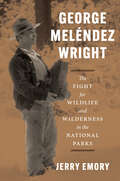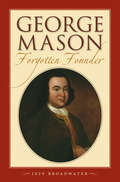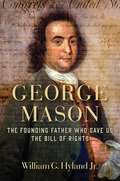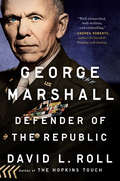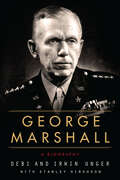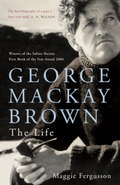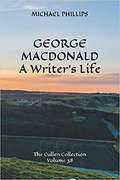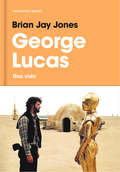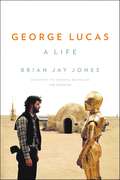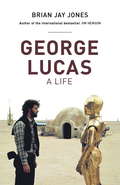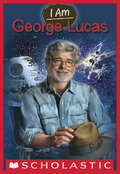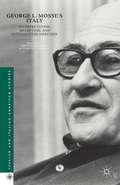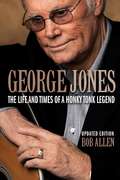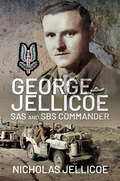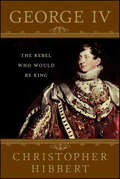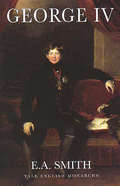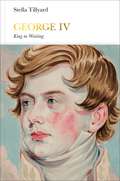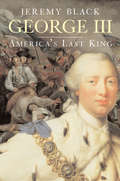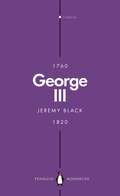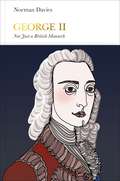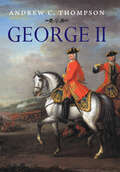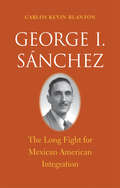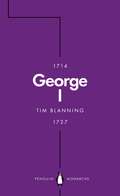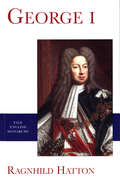- Table View
- List View
George Meléndez Wright: The Fight for Wildlife and Wilderness in the National Parks
by Jerry EmoryThe first biography of a visionary biologist whose groundbreaking ideas regarding wildlife and science revolutionized national parks. When twenty-three-year-old George Meléndez Wright arrived in Yosemite National Park in 1927 to work as a ranger naturalist—the first Hispanic person to occupy any professional position in the National Park Service (NPS)—he had already visited every national park in the western United States, including McKinley (now Denali) in Alaska. Two years later, he would organize the first science-based wildlife survey of the western parks, forever changing how the NPS would manage wildlife and natural resources. At a time when national parks routinely fed bears garbage as part of “shows” and killed “bad” predators like wolves, mountain lions, and coyotes, Wright’s new ideas for conservation set the stage for the modern scientific management of parks and other public lands. Tragically, Wright died in a 1936 car accident while working to establish parks and wildlife refuges on the US-Mexico border. To this day, he remains a celebrated figure among conservationists, wildlife experts, and park managers. In this book, Jerry Emory, a conservationist and writer connected to Wright’s family, draws on hundreds of letters, field notes, archival research, interviews, and more to offer both a biography of Wright and a historical account of a crucial period in the evolution of US parks and the wilderness movement. With a foreword by former NPS director Jonathan B. Jarvis, George Meléndez Wright is a celebration of Wright’s unique upbringing, dynamism, and enduring vision that places him at last in the pantheon of the great American conservationists.
George Mason, Forgotten Founder
by Jeff BroadwaterGeorge Mason (1725-92) is often omitted from the small circle of founding fathers celebrated today, but in his service to America he was, in the words of Thomas Jefferson, "of the first order of greatness." Jeff Broadwater provides a comprehensive account of Mason's life at the center of the momentous events of eighteenth-century America. Mason played a key role in the Stamp Act Crisis, the American Revolution, and the drafting of Virginia's first state constitution. He is perhaps best known as author of the Virginia Declaration of Rights, a document often hailed as the model for the Bill of Rights.As a Virginia delegate to the Constitutional Convention in Philadelphia, Mason influenced the emerging Constitution on point after point. Yet when he was rebuffed in his efforts to add a bill of rights and concluded the document did too little to protect the interests of the South, he refused to sign the final draft. Broadwater argues that Mason's recalcitrance was not the act of an isolated dissenter; rather, it emerged from the ideology of the American Revolution. Mason's concerns about the abuse of political power, Broadwater shows, went to the essence of the American experience.
George Mason: The Founding Father Who Gave Us the Bill of Rights (George Mason Lectures #Vol. Vi)
by William G. Hyland Jr.George Mason was a short, bookish man who was a friend and neighbor of athletic, broad-shouldered George Washington. Unlike Washington, Mason has been virtually forgotton by history. But this new biography of forgotten patriot George Mason makes a convincing case that Mason belongs in the pantheon of honored Founding Fathers. Trained in the law, Mason was also a farmer, philosopher, botanist, and musician. He was one of the architects of the Declaration of Independence, an author of the Bill of Rights, and one of the strongest proponents of religious liberty in American history. In fact, both Thomas Jefferson and James Madison may have been given undue credit for George Mason's own contributions to American democracy.
George Marshall: Defender of the Republic
by David L. RollThe extraordinary career of George Catlett Marshall—America&’s most distinguished soldier–statesman since George Washington—whose selfless leadership and moral character influenced the course of two world wars and helped define the American century. &“I&’ve read several biographies of Marshall, but I think [David] Roll&’s may be the best of the bunch.&”—Thomas E. Ricks, New York Times Book Review • &“Powerful.&”—The Wall Street Journal • &“Enthralling.&”—Andrew Roberts • &“Important.&”—William I. Hitchcock • &“Majestic.&”—Susan Page • &“Engrossing.&”—Andrew J. Bacevich • &“Judicious.&”—Walter Isaacson • &“Definitive.&”—Kirkus Winston Churchill called him World War II's "organizer of victory." Harry Truman said he was "the greatest military man that this country ever produced." Today, in our era of failed leadership, few lives are more worthy of renewed examination than Marshall and his fifty years of loyal service to the defense of his nation and its values. Even as a young officer he was heralded as a genius, a reputation that grew when in WWI he planned and executed a nighttime movement of more than a half million troops from one battlefield to another that led to the armistice. Between the wars he helped modernize combat training, and re-staffed the U.S. Army's officer corps with the men who would lead in the next decades. But as WWII loomed, it was the role of army chief of staff in which Marshall's intellect and backbone were put to the test, when his blind commitment to duty would run up against the realities of Washington politics. Long seen as a stoic, almost statuesque figure, he emerges in these pages as a man both remarkable and deeply human, thanks to newly discovered sources. Set against the backdrop of five major conflicts—two world wars, Palestine, Korea, and the Cold War—Marshall's education in military, diplomatic, and political power, replete with their nuances and ambiguities, runs parallel with America's emergence as a global superpower. The result is a defining account of one of our most consequential leaders.
George Marshall: A Biography
by Debi Unger Irwin Unger“Elegant and iconoclastic . . . refreshing . . . persuasive.”—NEW YORK TIMES BOOK REVIEWHere is the first biography to offer a complete picture of the life of George C. Marshall, chief of staff of the U.S. Army from 1939 to 1945 and the military leader who actually ran World War II for America as he oversaw all personnel and logistics.Following Marshall from his childhood in western Pennsylvania and his training at the Virginia Military Institute to his role during and after World War II and his death in 1959 at the age of seventy-eight, this biography casts light on the inspiration he took from historical role models, such as George Washington and Robert E. Lee, and his relationships with military brass, the Washington political establishment, and world leaders, from Harry Truman to Chiang Kai-shek. It also explores Marshall’s triumphs and defeats during World War II, and his contributions through two critical years of the emerging Cold War—including the transformative Marshall Plan, which saved Western Europe from Soviet domination, and his failed attempt to unite China’s Nationalists and Communists.Based on exhaustive research and filled with rich detail, George Marshall is sure to be hailed as the definitive work on one of the most influential figures in American history.“A grand but judicious biography of a fascinating man.”—Evan Thomas, author of Ike’s Bluff
George Mackay Brown
by Maggie FergussonGeorge Mackay Brown was one of Scotland's greatest twentieth-century writers, but in person a bundle of paradoxes. He had a wide international reputation, but hardly left his native Orkney. A prolific poet, admired by such fellow poets as Seamus Heaney, Ted Hughes and Charles Causley, and hailed by the composer Peter Maxwell Davies as 'the most positive and benign influence ever on my own efforts at creation', he was also an accomplished novelist (shortlisted for the 1994 Booker Prize for Beside the Ocean of Time) and a master of the short story. When he died in 1996, he left behind an autobiography as deft as it is ultimately uninformative. 'The lives of artists are as boring and also as uniquely fascinating as any or every other life,' he claimed. Never a recluse, he appeared open to his friends, but probably revealed more of himself in his voluminous correspondence with strangers. He never married - indeed he once wrote, 'I have never been in love in my life.' But some of his most poignant letters and poems were written to Stella Cartwright, 'the Muse of Rose Street', the gifted but tragic figure to whom he was once engaged and with whom he kept in touch until the end of her short life.Maggie Fergusson interviewed George Mackay Brown several times and is the only biographer to whom he, a reluctant subject, gave his blessing. Through his letters and through conversations with his wide acquaintance, she discovers that this particular artist's life was not only fascinating but vivid, courageous and surprising.
George Mackay Brown: The Life
by Maggie FergussonGeorge Mackay Brown was one of Scotland's greatest twentieth-century writers, but in person a bundle of paradoxes. He had a wide international reputation, but hardly left his native Orkney. A prolific poet, admired by such fellow poets as Seamus Heaney, Ted Hughes and Charles Causley, and hailed by the composer Peter Maxwell Davies as 'the most positive and benign influence ever on my own efforts at creation', he was also an accomplished novelist (shortlisted for the 1994 Booker Prize for Beside the Ocean of Time) and a master of the short story. When he died in 1996, he left behind an autobiography as deft as it is ultimately uninformative. 'The lives of artists are as boring and also as uniquely fascinating as any or every other life,' he claimed. Never a recluse, he appeared open to his friends, but probably revealed more of himself in his voluminous correspondence with strangers. He never married - indeed he once wrote, 'I have never been in love in my life.' But some of his most poignant letters and poems were written to Stella Cartwright, 'the Muse of Rose Street', the gifted but tragic figure to whom he was once engaged and with whom he kept in touch until the end of her short life.Maggie Fergusson interviewed George Mackay Brown several times and is the only biographer to whom he, a reluctant subject, gave his blessing. Through his letters and through conversations with his wide acquaintance, she discovers that this particular artist's life was not only fascinating but vivid, courageous and surprising.
George MacDonald: The Cullen Collection Volume 38 (The Cullen Collection #38)
by Michael PhillipsThe leading MacDonald scholar and biographer presents the most comprehensive work to date on the 19th century author&’s life and work. Best known for his fiction and fairy tales, such as the immortal classics Robert Falconer and At the Back of the North Wind, the Victorian author and theologian George MacDonald inspired some of the greatest writers of the 19th and 20th centuries. Most notably, C.S. Lewis credits MacDonald&’s books with inspiring his works of fantasy fiction as well as putting him on the path to Christianity. In this major biographical work, MacDonald scholar Michael Phillips examines how the events of the author&’s life contributed to his work and legacy. Referring to this volume as a &“bibliographic biography,&” Phillips brings his expertise to bear on the complete corpus of MacDonald&’s fiction, pointing out each book&’s essential themes, and offering insights into how each title can be most perceptively be read.
George Lucas: Una vida
by Brian Jay JonesLa biografía más completa jamás escrita sobre uno de los cineastas más admirados e influyentes de los últimos cincuenta años: Georges Lucas. El 25 de mayo de 1977 se estrenó en apenas cuarenta salas estadounidenses un film con todos los números para fracasar. Sin embargo, pronto mereció grandiosos titulares hasta convertirse en un fenómeno de taquilla que cambió de un plumazo la manera de producir, anunciar y rentabilizar películas. La cinta se titulaba Star Wars y su creador era un tal George Lucas. El cineasta aún volvería a dar el golpe con la saga de Indiana Jones y, no contento con ello, llegó a forjar pequeños imperios: Lucasfilm, THX, Industrial Light & Magic, Pixar. En esta biografía, tanto colegas como competidores de Lucas ofrecen una mirada exhaustiva sobre la vida y los métodos de trabajo de un hombre que transformó la manera de hacer cine y de verlo. Reseñas:«Todo en la trayectoria de Lucas en el cine, desde sus inicios hasta su actual estatus de leyenda, todo está aquí. Los retratos que ofrecen colegas, rivales, mentores y amigos son brutalmente honestos. Una biografía indispensable.»Rolling Stone «Un libro adictivo. Jones retrata a la perfección la presión asfixiante del creador, los encontronazos con los estudios y el baile constante con el fracaso que precedieron a obras maestras como American Graffiti o Star Wars.»BBC «Una biografía clara y veraz, donde hasta el más mínimo detalle sorprende.»The New York Times «Como si de un aguerrido arqueólogo se tratara, Jones sale victorioso del reto, llevando bajo el brazo un relato formidablemente completo de la vida y obra de George Lucas.»Washington Post «Con su prosa hipnótica y sus investigaciones en profundidad, este libro gustará hasta a los seguidores más exigentes de Lucas.»Boston Globe «Incluso los años de formación del director están retratados con maestría. También las reflexiones e interioridades de cómo funciona la industria del cine (y cómo la cambió Lucas) se nos aparecen como una aventura trepidante.»Chicago Tribune
George Lucas: A Life
by Brian Jay JonesThe essential biography of the influential and beloved filmmaker George LucasOn May 25, 1977, a problem-plagued, budget-straining independent science-fiction film opened in a mere thirty-two American movie theaters. Conceived, written, and directed by a little-known filmmaker named George Lucas, the movie originally called The Star Wars quickly drew blocks-long lines, bursting box-office records and ushering in a new way for movies to be made, marketed, and merchandised. It is now one of the most adored-and successful-movie franchises of all time.Now, the author of the bestselling biography Jim Henson delivers a long-awaited, revelatory look into the life and times of the man who created Luke Skywalker, Han Solo, and Indiana Jones. If Star Wars wasn't game-changing enough, Lucas went on to create another blockbuster series with Indiana Jones, and he completely transformed the world of special effects and the way movies sound. His innovation and ambition forged Pixar and Lucasfilm, Industrial Light & Magic, and THX sound. Lucas's colleagues and competitors offer tantalizing glimpses into his life. His entire career has been stimulated by innovators including Steven Spielberg and Francis Ford Coppola, actors such as Harrison Ford, and the very technologies that enabled the creation of his films-and allowed him to keep tinkering with them long after their original releases. Like his unforgettable characters and stories, his influence is unmatched.
George Lucas: A Life
by Brian Jay JonesGeorge Lucas by Brian Jay Jones is the first comprehensive telling of the story of the iconic filmmaker and the building of his film empire, as well as of his enormous impact on cinema. At once a biography, a business manual, and a film history, George Lucas will, for the first time explore the life and work of a fiercely independent writer/director/producer who became one of the most influential filmmakers and cultural icons - a true game changer.On May 25, 1977, a problem-plagued, budget-straining, independent science fiction film opened in a mere thirty-two American movie theatres. Its distributor - 20th Century Fox - were baffled by the film. The film's production had been a disaster from nearly day one, hampered by bad weather, malfunctioning props and ill-fitting costumes. But its release on a quiet Wednesday in May of 1977, changed cinema forever. The film was Star Wars.The fiercely independent thirty-three year-old George Lucas was just getting going. Determined to control every element of the film-making process he had founded Lucasfilm ltd., in 1971. Among his hits, Lucas gave us six Star Wars films and four featuring the globetrotting archaeologist Indiana Jones. Together these ten films have earned more than $6 billion worldwide and won some of the largest and most devoted fan bases ever seen. In 2013 he sold Lucasfilm to Disney for $4.05 billion. Along the way the man who invented the Blockbuster also gave us computer generated imagery (CGI), created a small animation company called Pixar and reinvented the way movies were made, marketed and merchandised.
George Lucas (I Am #7)
by Ms. Grace NorwichI created the Star Wars franchise. I am George Lucas.Learn all about this remarkable man, whose accomplishments are truly inspiring, in the continuation of the I AM series. I AM GEORGE LUCAS will follow one man's journey to become the most famous filmmaker in the world. Discover everything you wanted to know about this celebrated movie guru and creator of Star Wars. This book will feature a full-color illustrated cover, one-color illustrations throughout, a detailed time line, introductions to other notable people from the story, sidebars, and a top-ten list of important things to know about George Lucas.
George L. Mosse’s Italy
by Lorenzo Benadusi Giorgio CaravaleTwelve years have gone by since the passing of George L. Mosse, yet his work still provides essential tools for historical analysis and influences contemporary research. This volume provides a re-examination of his historiographical production and an analysis of his influence in the context of Italian history.
George Jones: The Life and Times of a Honky Tonk Legend
by Bob AllenGeorge Jones's nearly 60-year recording and performing career has had a profound influence on modern country music and influenced a younger generation of singers, including Garth Brooks, Alan Jackson, Randy Travis, Tim McGraw, and Trace Adkins. As Merle Haggard said of Jones in Rolling Stone magazine, “His voice was like a Stradivarius violin: one of the greatest instruments ever made.” Jones's saga is a larger-than-life tale of rags to riches and back to rags again. He was born into near poverty in a backwater patch of East Texas. His formal education ended early; by his early teens, he was singing on the streets of Beaumont, Texas, for tips. After beginning to record in the mid-1950s Jones became, by sheer dint of his vocal prowess, one of Nashville's most celebrated honky-tonk singers. But from the start, Jones's life, as often reflected in his music, was shaped by misdirection, chaos, turmoil, and emotional strife aggravated by a ferocious appetite for alcohol. Fame and adulation seemed to merely intensify his personal travails. Jones's story has a relatively happy ending. With the help of fourth wife Nancy during the final decade and a half of his life, he got clean and sober, was feted as a much-revered elder statesman for the music, and, by most accounts, found peace of mind at long last.
George Jellicoe: SAS and SBS Commander
by Nicholas C. JellicoeGeorge Jellicoe, son of Admiral Sir John Jellicoe, commander of the British Grand Fleet at Jutland, was never compromised by his privileged upbringing. In this insightful biography, his son describes a life of action, drama, public service and controversy. George’s exploits with the newly formed SAS, as David Stirling’s second-in-command, and later commanding the SBS, make for fascinating reading. Over four years it embraced the North African and Mediterranean campaigns and culminated in the saving of a newly-liberated Athens from the communist guerrillas of ELAS. The brutality of Stalinist communism led him to join the post-war Foreign Office. In Washington he worked with Kim Philby and Donald Maclean in the cloak and dagger world of espionage. Resigning in 1958 so he could marry the woman he loved, he turned to politics. Although his ministerial career ended in 1973 after unwittingly become entangled with the Lambton scandal, he continued to sit in the House of Lords becoming ‘Father of the House’. He held numerous public appointments including President of the Royal Geographical Society, Chairman of the Medical Research Council, President of the SAS Regimental Association and the UK Crete Veterans Association. Thanks to the author’s research and access, this is more than a biography of a significant public figure. It provides fascinating detail of Special Forces operations and the characters of the countless figures with whom he mixed.
George IV: The Rebel Who Would Be King
by Christopher HibbertHibbert delivers a superbly detailed picture of the life and times of George IV including his exorbitant spending on his homes, his clothes, and his women; his patronage of the arts; his 'illegal' marriage to Catholic Mrs Fitzherbert, and lesser known facts such as his generous charity donations andhis witty one-liners, including one he uttered when he met his bride-to-be (Caroline of Brunswick) for the first time: 'Harris, I am not well, fetch me a brandy.' George IV was the son of George III (whowent insane and inspired 'The Madness of King George') and was the founder of the prestigiousKing's College in London.
George IV
by E. A. SmithThis engrossing biography of George IV, king of England from 1820 to 1830, gives a full and objective reassessment of the monarch's character, reputation, and achievement. Previous writers have tended to accept the unfavorable verdicts of the king's contemporaries that he was a dissolute, pleasure-loving dilettante and a feeble and ineffective ruler who was responsible for the decline of the power and reputation of the monarchy in the early nineteenth century. Now E.A. Smith offers a new view of George IV, one that does not minimize the king's faults but focuses on the positive qualities of his achievement in politics and in the patronage of the arts.Smith explores the roots of the king's character and personality, stressing the importance of his relationship with his parents and twelve surviving siblings. He examines the king's important contributions to the cultural enhancement of his capital and his encouragement of the major artistic, literary, and scholarly figures of his time. He reassesses the king's role as constitutional monarch, contending that it was he, rather than Victoria and Albert, who created the constitutional monarchy of nineteenth-century Britain and began the revival of its popularity. Smith's biography not only illuminates the character of one of the most colorful of Britain's rulers but also contributes to the history of the British monarchy and its role in the nation's life.
George IV: King in Waiting (Penguin Monarchs)
by Stella TillyardGeorge IV spent most of his life waiting to become king: as a pleasure-loving and rebellious Prince of Wales during the sixty-year reign of his father, George III, and for ten years as Prince Regent, when his father went mad. 'The days are very long when you have nothing to do' he once wrote plaintively, but he did his best to fill them with pleasure - women, art, food, wine, fashion, architecture. He presided over the creation of the Regency style, which came to epitomise the era, and he was, with Charles I, the most artistically literate of all our kings. Yet despite his life of luxury and indulgence, George died alone and unmourned. Stella Tillyard has not written a judgemental book, but a very human and enjoyable one, about this most colourful of all British kings.
George III
by Jeremy BlackThe sixty-year reign of George III (1760-1820) witnessed and participated in some of the most critical events of modern world history: the ending of the Seven Years' War with France, the American War of Independence, the French Revolutionary Wars, the campaign against Napoleon Bonaparte and battle of Waterloo in 1815, and Union with Ireland in 1801. Despite the pathos of the last years of the mad, blind, and neglected monarch, it is a life full of importance and interest.Jeremy Black's biography deals comprehensively with the politics, the wars, and the domestic issues, and harnesses the richest range of unpublished sources in Britain, Germany, and the United States. But, using George III's own prolific correspondence, it also interrogates the man himself, his strong religious faith, and his powerful sense of moral duty to his family and to his nation. Black considers the king's scientific, cultural, and intellectual interests as no other biographer has done, and explores how he was viewed by his contemporaries. Identifying George as the last British ruler of the Thirteen Colonies, Black reveals his strong personal engagement in the struggle for America and argues that George himself, his intentions and policies, were key to the conflict.
George III: Madness and Majesty (Penguin Monarchs)
by Jeremy BlackKing of Britain for sixty years and the last king of what would become the United States, George III inspired both hatred and loyalty and is now best known for two reasons: as a villainous tyrant for America's Founding Fathers, and for his madness, both of which have been portrayed on stage and screen.In this concise and penetrating biography, Jeremy Black turns away from the image-making and back to the archives, and instead locates George's life within his age: as a king who faced the loss of key colonies, rebellion in Ireland, insurrection in London, constitutional crisis in Britain and an existential threat from Revolutionary France as part of modern Britain's longest period of war.Black shows how George III rose to these challenges with fortitude and helped settle parliamentary monarchy as an effective governmental system, eventually becoming the most popular monarch for well over a century. He also shows us a talented and curious individual, committed to music, art, architecture and science, who took the duties of monarchy seriously, from reviewing death penalties to trying to control his often wayward children even as his own mental health failed, and became Britain's longest reigning king.
George II: Not Just a British Monarch (Penguin Monarchs)
by Norman DaviesFrom the celebrated historian and author of Europe: A History, a new life of George IIGeorge II, King of Great Britain and Ireland and Elector of Hanover, came to Britain for the first time when he was thirty-one. He had a terrible relationship with his father, George I, which was later paralleled by his relationship to his own son. He was short-tempered and uncultivated, but in his twenty-three-year reign he presided over a great flourishing in his adoptive country - economic, military and cultural - all described with characteristic wit and elegance by Norman Davies. (George II so admired the Hallelujah chorus in Handel's Messiah that he stood while it was being performed - as modern audiences still do.) Much of his attention remained in Hanover and on continental politics, as a result of which he was the last British monarch to lead his troops into battle, at Dettingen in 1744.
George II: King and Elector (The English Monarchs Series)
by Andrew C. ThompsonDespite a long and eventful reign, Britain's George II is a largely forgotten monarch, his achievements overlooked and his abilities misunderstood. This landmark biography uncovers extensive new evidence in British and German archives, making possible the most complete and accurate assessment of this thirty-three-year reign. Andrew C. Thompson paints a richly detailed portrait of the many-faceted monarch in his public as well as his private life. Born in Hanover in 1683, George Augustus first came to London in 1714 as the new Prince of Wales. He assumed the throne in 1727, held it until his death in 1760, and has the distinction of being Britain's last foreign-born king and the last king to lead an army in battle. With George's story at its heart, the book reconstructs his thoughts and actions through a careful reading of the letters and papers of those around him. Thompson explores the previously underappreciated roles George played in the political processes of Britain, especially in foreign policy, and also charts the intricacies of the king's complicated relationships and reassesses the lasting impact of his frequent return trips to Hanover. George II emerges from these pages as an independent and cosmopolitan figure of undeniable historical fascination.
George I. Sánchez
by Carlos Kevin BlantonGeorge I. Sánchez was a reformer, activist, and intellectual, and one of the most influential members of the "Mexican American Generation" (1930-1960). A professor of education at the University of Texas from the beginning of World War II until the early 1970s, Sánchez was an outspoken proponent of integration and assimilation. He spent his life combating racial prejudice while working with such organizations as the ACLU and LULAC in the fight to improve educational and political opportunities for Mexican Americans. Yet his fervor was not always appreciated by those for whom he advocated, and some of his more unpopular stands made him a polarizing figure within the Latino community.Carlos Blanton has published the first biography of this complex man of notable contradictions. The author honors Sánchez's efforts, hitherto mostly unrecognized, in the struggle for equal opportunity, while not shying away from his subject's personal faults and foibles. The result is a long-overdue portrait of a towering figure in mid-twentieth-century America and the all-important cause to which he dedicated his life: Mexican American integration.
George I: The Lucky King (Penguin Monarchs)
by Tim BlanningGeorge I was not the most charismatic of the Hanoverian monarchs to have reigned in England but he was probably the most important. He was certainly the luckiest.Born the youngest son of a landless German duke, he was taken by repeated strokes of good fortune to become, first the ruler of a major state in the Holy Roman Empire of the German Nation and then the sovereign of three kingdoms (England, Ireland and Scotland). Tim Blanning's incisive short biography examines George's life and career as a German prince, and as King. Fifty-four years old when he arrived in London in 1714, he was a battle-hardened veteran, who put his long experience and deep knowledge of international affairs to good use in promoting the interests of both Hanover and Great Britain. When he died, his legacy was order and prosperity at home and power and prestige abroad. Disagreeable he may have been to many, but he was also tough, determined and effective, at a time when other European thrones had started to crumble.
George I
by Ragnhild HattonIn 1714 George Ludwig, the fifty-eight-year-old elector of Brunswick-Luneburg, became, as George I, the first of the Hanoverian dynasty to rule Britain. Until his death in 1727 George served as both elector of Hanover and British monarch. An enigmatic figure whose real character has long been concealed by anti-Hanoverian propaganda, George emerges in this groundbreaking biography as an impressive ruler who welcomed the responsibilities the accession brought him and set out to bring culture to what he considered the unsophisticated English nation.Ragnhild Hatton's biography is the only comprehensive account of George's life and reign. It draws on a wide range of archival sources in several languages to illuminate the fascinating details of George's early life and dynastic crises, his plans and ambitions for the British nation, the impact of his rationalist ideas, and his accomplishments as king. The book also examines the king's private life, his family relationships in both Prussia and England, his private interest in music and the arts, and the improvement of his British and Hanoverian properties.
